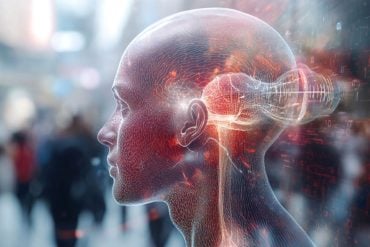Summary: Researchers have made a novel discovery regarding rhythmic brain signals known as theta oscillations.
These neural dances, primarily observed in the hippocampus, were previously thought to be driven mostly by external events. However, the study revealed that memory recall actually stirs up more of these oscillations than real-time experiences.
This research carries implications for novel therapeutic strategies in conditions affecting memory, like seizures, stroke, and Parkinson’s disease.
Key Facts:
- The study found that theta oscillations, rhythmic brain signals, are more prevalent when a person is remembering events rather than experiencing them.
- The research suggests that memory could be leveraged to stimulate these oscillations within the brain, potentially leading to memory improvements in patients with cognitive impairments.
- The findings were derived from a unique virtual reality experiment involving epilepsy patients, providing an innovative approach to understanding the neural basis of memory.
Source: University of Arizona
Neurons produce rhythmic patterns of electrical activity in the brain. One of the unsettled questions in the field of neuroscience is what primarily drives these rhythmic signals, called oscillations.
University of Arizona researchers have found that simply remembering events can trigger them, even more so than when people are experiencing the actual event.
The researchers, whose findings are published in the journal Neuron, specifically focused on what are known as theta oscillations, which emerge in the brain’s hippocampus region during activities like exploration, navigation and sleep. The hippocampus plays a crucial role in the brain’s ability to remember the past.
Prior to this study, it was believed that the external environment played a more important role in driving theta oscillations, said Arne Ekstrom, professor of cognition and neural systems in the UArizona Department of Psychology and senior author of the study. But Ekstrom and his collaborators found that memory generated in the brain is the main driver of theta activity.
“Surprisingly, we found that theta oscillations in humans are more prevalent when someone is just remembering things, compared to experiencing events directly,” said lead study author Sarah Seger, a graduate student in the Department of Neuroscience.
The results of the study could have implications for treating patients with brain damage and cognitive impairments, including patients who have experienced seizures, stroke and Parkinson’s disease, Ekstrom said. Memory could be used to create stimulations from within the brain and drive theta oscillations, which could potentially lead to improvements in memory over time, he said.
UArizona researchers collaborated on the study with researchers from the University of Texas Southwestern Medical Center in Dallas, including neurosurgeon Dr. Brad Lega and research technician Jennifer Kriegel.
The researchers recruited 13 patients who were being monitored at the center in preparation for epilepsy surgery. As part of the monitoring, electrodes were implanted in the patients’ brains for detecting occasional seizures. The researchers recorded the theta oscillations in the hippocampus of the brain.
The patients participated in a virtual reality experiment, in which they were given a joystick to navigate to shops in a virtual city on a computer. When they arrived at the correct destination, the virtual reality experiment was paused.
The researchers asked the participants to imagine the location at which they started their navigation and instructed them to mentally navigate the route they just passed through. The researchers then compared theta oscillations during initial navigation to participants’ subsequent recollection of the route.
During the actual navigation process using the joystick, the oscillations were less frequent and shorter in duration compared to oscillations that occurred when participants were just imagining the route. So, the researchers conclude that memory is a strong driver of theta oscillations in humans.
One way to compensate for impaired cognitive function is by using cognitive training and rehabilitation, Ekstrom said.
“Basically, you take a patient who has memory impairments, and you try to teach them to be better at memory,” he said.
In the future, Ekstrom is planning to conduct this research in freely walking patients, as opposed to patients in beds, and observe how freely navigating compares to memory with regard to brain oscillations.
“Being able to directly compare the oscillations that were present during the original experience, and during a later retrieval of that, is a huge step forward in the field in terms of designing new experiments and understanding the neural basis of memory,” Seger said.
About this memory research news
Author: Niranjana Rajalakshmi
Source: University of Arizona
Contact: Niranjana Rajalakshmi – University of Arizona
Image: The image is credited to Neuroscience News
Original Research: Closed access.
“Memory-related processing is the primary driver of human hippocampal theta oscillations” by Sarah E. Seger et al. Neuron
Abstract
Memory-related processing is the primary driver of human hippocampal theta oscillations
Highlights
- The 3–12 Hz hippocampal “theta” oscillation in rodents is related to movement and linked to navigation
- Yet, theta oscillations are also observed in humans during verbal memory processing
- Here, we tested whether navigation or memory was the primary driver of human theta
- Results showed greater prevalence of human hippocampal theta during memory
Summary
Decades of work in rodents suggest that movement is a powerful driver of hippocampal low-frequency “theta” oscillations. Puzzlingly, such movement-related theta increases in primates are less sustained and of lower frequency, leading to questions about their functional relevance.
Verbal memory encoding and retrieval lead to robust increases in low-frequency oscillations in humans, and one possibility is that memory might be a stronger driver of hippocampal theta oscillations in humans than navigation.
Here, neurosurgical patients navigated routes and then immediately mentally simulated the same routes while undergoing intracranial recordings.
We found that mentally simulating the same route that was just navigated elicited oscillations that were of greater power, higher frequency, and longer duration than those involving navigation.
Our findings suggest that memory is a more potent driver of human hippocampal theta oscillations than navigation, supporting models of internally generated theta oscillations in the human hippocampus.







